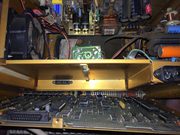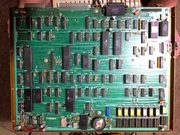
I've had a TRS80 Model 4P for many many years and for the life of me I can't find
if someone gave it to me or I found it at one of the many many car boot sales (yard sales) I went
to between 1998 and 2003.
Anyway, it never worked so it's been sat on a shelf until last week when someone on
the Vintage Computer Group on Facebook mentioned they'd got one and how cute it was and I thought 'it's
a 64K Z80 based machine, if the basics are working how hard can it be'.
PSU was a usual ASTEC suspect so the first thing to do before even THINKING about powering
up was to replace the RIFA mains filter capacitor, aka The Explodacap. Afterwards with an old DEC RZ28 hard drive
as a load the PSU tested good. The machine itself wasn't though, and just gave me raster lines if I turned
the brightness right up.
I removed the motherboard, cleaned it then reseated all the (thankfully) socketed chips.
This time I still got raster lines but the floppy drive tried seeking and with contrast right up I could
just see the boot logo. Excellent. However analogue video circuitry defeats me so some questions to the
excellent folk at the Classiccmp mailing list and the Vintage Computer Federation was soon pointing fingers
at the contrast amplification circuit.
Sure enough the final drive transistor that actually provides the contrast amplification for the
CRT was a dead short so I ordered up a couple of spares and the screen burst into life :D In case anyone's curious
said transistor is a 2SC2228 160V BJT NPN, a snip at £2.49ea.
RAM test next. The machine has a tester built-in which is started by holding '.' and resetting. It
instantly brought up errors right at the top of RAM at 0xF700 writing 0xAA (10101010) but reading back 0xCA (11001010). This shows a fault
with bits 5 and 6 so I swapped those two chips with NOS ones I happened to have and the RAM faults disappeared.
Another worker!
Pictures
 |  | ||